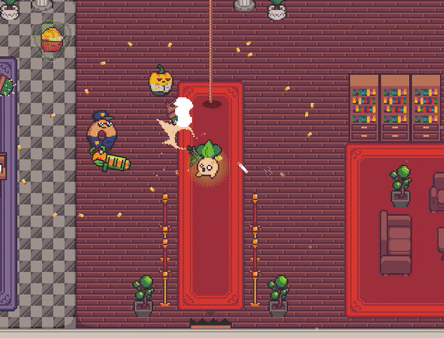Turnip Boy Robs a Bank [Review]
Turnip Boy Robs a Bank is a very interesting semi-rogue-lite game developed by Snoozy Kazoo and published by Graffiti Games. In this game, you play as, you guessed it, a turnip that robs banks. This game is pretty wild all around. It starts by saying your character defeated a god and started a civil war. I’m sure you can get the context for that story in the first game, Turnip Boy Commits Tax Evasion. From what I’ve seen in the first game, this one is very different gameplay-wise. You do have the same sword and there are definitely recurring characters. And while I haven’t personally played the first game (yet), there are some interesting references like the character that told me I had killed her grandmother by uttering the word “stop”. From what I can tell, Turnip Boy is some sort of eldritch horror.
While I had a little confusion at the beginning, just being unfamiliar with the story, I thoroughly enjoyed the game! After a short tutorial, you crash into a bank and the game starts right up. This is where the rogue-lite comes in. You go through the same level multiple times, gathering as much money as you can by shaking random people down, killing enemies, and stealing pricey artifacts. You can use this money to buy things off of the black market like a laser cutter to cut open safes or a lantern to light a dark area. You can also purchase items and upgrades from a roided-up cyborg radish. From another money bag to increase how much cash you can carry to a clock that increases the duration of the run time. Oh did I not mention that? The runs are timed. Starting at three minutes, that’s all you have to steal as much stuff as you can then get out because if you don’t leave in time the cops will start dropping in from the sky and you gain a star rating that continues to go up. Best to get to the truck or train as fast as you can. Because if you die, you lose half the money and drop all the artifacts you stole. The timer isn’t all that bad though, it stops when you face off against bosses as they will take more than a minute or so to defeat.
There is a slight randomized aspect to the game so you don’t get bored of the same level too quickly. While the floor plan is always the same, the elevators you come across take you to different floors each time you start a run. Usually, they take you to small floors with a few rooms that have a bunch of safes, or a room with lasers you have to turn off to find your way to a big safe room that you have to use C4 to get into. Occasionally it will take you to a room with an NPC that has a request for you. There are small missions you can complete throughout the runs, you don’t have to finish the quest in the same run you find it in, and you can take your time with it. Usually, all you get from these quests is a hat but honestly, as long as you talk to all the NPCs with an icon on their head you will just naturally complete them over time. Plus you get to see the fun humor of the game when you talk to them! Like how one mission is to shake down someone for their divorce papers they refuse to sign or collect tax from an acorn who gives you his “scalp” as a reward. The elevators also have a chance to take you to a rave. Well, sort of, it's actually just a disco floor with one guy but he’ll sell you songs to listen to while playing the game! They do however cost souls, but he’ll give you a scythe you can use to reap. The game allows you to hold two weapons, so I exchanged one for the scythe for a few runs while I maxed out my souls. A nice change of pace from other roguelites is that the weapons you get from the run can actually be exchanged back at the safe house for experience. This levels up your weapons and allows you a new weapon at each level. You can start with any two of these weapons you unlock by selecting them on the weapon wall.
Turnip Boy Robs a Bank is a very intriguing game that is a fantastic sequel to the first game and does enough to make you want more. Now I need to get my hands on the first game.
This Review was made possible using the Steam Deck Oled




